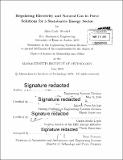Regulating electricity and natural gas in Peru : solutions for a sustainable energy sector
Author(s)
Breckel, Alex Cade
DownloadFull printable version (4.598Mb)
Other Contributors
Massachusetts Institute of Technology. Technology and Policy Program.
Advisor
Ignacio Perez-Arriaga and Carlos Batlle Lopéz.
Terms of use
Metadata
Show full item recordAbstract
Peru is one of the fastest growing countries in Latin America, thanks in part to industry fueled by generous endowments of hydro power capacity and natural gas reserves. However, investment in electricity generation capacity has not kept pace with the rapid increase in demand and threatens to stymie future economic growth. A flawed regulatory environment is to blame, and specific roadblocks to increased generation investments include a dysfunctional capacity payment system, low administratively determined gas prices, and structural barriers to investment in hydro. This thesis provides an overview of the design, functioning and historical context for energy regulation in Peru; identifies the key barriers to generation investment; analyzes two potential regulatory reforms; and recommends the specific reform that has the most promise for reigniting investment in hydro. Two reforms strike at the root of the current problem: The first, increasing the price of natural gas for power generators up to the economic netback value of LNG exports, would make hydro a viable investment but would hit consumers with very large increases in their electricity bills. An alternative approach, a reform to the capacity payment mechanism, could provide the same benefits in terms of drawing new generator investment but at a much lower cost to consumers. It would also offer benefits for regulatory discretion in the future evolution of the grid.
Description
Thesis: S.M. in Technology and Policy, Massachusetts Institute of Technology, Engineering Systems Division, Technology and Policy Program, 2014. Cataloged from PDF version of thesis. Includes bibliographical references (pages 57-59).
Date issued
2014Department
Massachusetts Institute of Technology. Engineering Systems Division; Technology and Policy ProgramPublisher
Massachusetts Institute of Technology
Keywords
Engineering Systems Division., Technology and Policy Program.